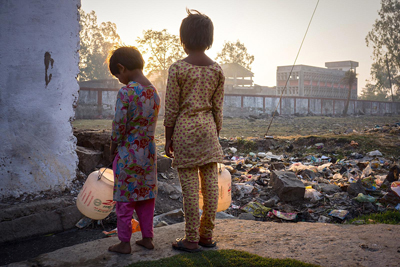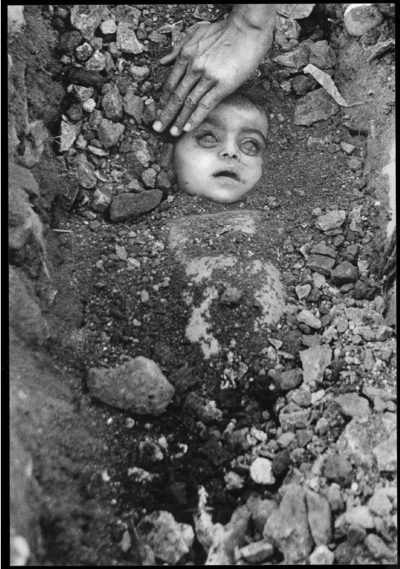
The two young girls pictured standing outside of the abandoned Union Carbide factory are holding water cannisters. Water pumped up from the groundwater aquifer in this area is heavily contaminated with toxic chemicals and the girls are on an early morning run to collect water for their family. Who knows where they will find their water and what harmful substances it might contain.
Photographer Giles Clarke, a photojournalist with Getty Images Reportage, just happens to be a good friend of the BMA and has taken it upon himself to document the ongoing water contamination crisis in Bhopal. Giles has made eight trips to Bhopal, over the last decade, and has built a stunning body of work. He’s not only won plaudits for his effort but has been the recipient of many awards and we’re proud to announce the latest of these now.
Giles’ photo essay ‘Bhopal: Child Victims of a Toxic Legacy’ has received a 3rd place award in the Editorial category of the International Photography Awards but, more importantly, the individual picture shown here has been selected as one of only 40, from the 20,000 plus competing images, curated as the 2018 International Photo Awards ‘Best in Show’ exhibition.
The Best of Show Exhibition will be part of an exclusive show in New York during the week leading up to the Lucie Awards Gala. The Best of Show Exhibition then travels to various countries to be included in photo festivals, and other photography related events throughout the following year in NYC, LA, Moscow, Paris, Budapest, Tokyo, Shanghai, and elsewhere.
The exhibition receives extensive press coverage and we trust that those exposed to Giles’ great work will take further interest in a subject he has studied with real depth. The pictures will also be published in the International Photography Awards annual book.
At the Lucie Awards another photographer inextricably linked with Bhopal will become the 2018 Honouree for ‘Achievement in Photojournalism’. Raghu Rai, a Magnum photographer, will forever be remembered for what has become the most iconic photo of the Bhopal Disaster.

The photo is described on our own website by the author Indra Sinha:
This famous, terrible and tender picture was taken by Magnum photographer Raghu Rai on the morning of December 3rd, 1984, after the night of horror in Bhopal when a huge cloud of poison gas 500 times more toxic than hydrogen cyanide spewed from a factory belonging to Union Carbide Corporation.
Thousands died in hideous ways. As the sun rose on streets full of corpses, Raghu found himself in a graveyard where a man was burying his young daughter. The father had covered the tiny body but then, unable to bear parting from her, brushed the earth away for one last look.
For the Bhopalis this picture has come to symbolise over 30 years of unimaginable suffering, an injustice never righted, crimes unpunished, and a community that most of the world has forgotten.
Giles Clarke’s photo essay ‘Bhopal: Child Victims of a Toxic Legacy’
Ragu Rhai, 2018 Honouree for ‘Achievement in Photojournalism’
Giles Clarke was previously winner of the Lucie Foundation: International Photography Awards – 1st Place, Deeper Perspective Award for his series Yemen In Crisis.


